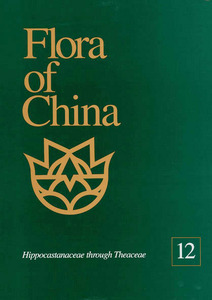Hippocastanaceae
Nianhe, Xia, Turland, Nicholas J., and Gadek, Paul A. (2007) Hippocastanaceae. In: Wu, Zhengyi, Raven, Peter H., and Hong, Deyuan, (eds.) Flora of China: Hippocastanaceae through Theaceae. Science Press, Beijing, China, pp. 1-4.
![[img]](https://researchonline.jcu.edu.au/16170/3.hassmallThumbnailVersion/16170_Nianhe_et_al_2007_Cover.jpg)
|
Image (JPEG) (Book Cover)
- Cover Image
Download (48kB) |
|
|
PDF (Published Version)
- Published Version
Restricted to Repository staff only |
Abstract
[Extract] Trees or shrubs, usually deciduous [evergreen in Billia Peyritsch]. Bark gray to brown, smooth or rough. Branchlets brown, green, or purplish, terete, glabrous, or puberulent to densely villous when young, covered with white to yellow lenticels. Winter buds terminal or axillary, with imbricate scales [without scales in Billia]. Leaves opposite, long petiolate, exstipulate; leaf blade palmately 5–11-foliolate [3-foliolate in Billia]; leaflets sessile or petiolulate; leaflet blades often unequal (middle ones larger), lanceolate to oblanceolate or oblong, abaxially glabrous or hairy, adaxially glabrous, base cuneate to cordate, margin crenate to serrate or compoundly so, or entire, apex acute to caudate. Inflorescence a terminal thyrse, usually erect, cylindric to conic; branches simple or compound; bracts subulate, small, absent in Aesculus. Flowers often rather large and showy, somewhat zygomorphic, bisexual or many of them (especially upper ones) functionally male. Sepals 4 or 5, nearly free or connate to form a tubular to campanulate calyx tube. Petals 4 or 5, free, imbricate, ± equal to unequal. Nectary disk small, annular, often unilateral, slightly divided or not. Stamens 5–8, hypogynous, inserted on inner side of disk, free, unequal, exceeding petals, inner whorl of 5, complete, outer whorl incomplete; filament arcuate distally; anther dehiscing longitudinally. Ovary superior, (2 or)3(or 4)-loculed; ovules 2 per locule, placentation axile; style 1, terminal, long and slender or short; stigma entire to 3-lobed. Fruit a loculicidal capsule, depressed globose to pyriform, with a long gynophore in Handeliodendron, often functionally 1-valved and 1-seeded by abortion, apex often mucronate; pericarp leathery, sometimes thickly so, usually smooth, often dotted, rarely verrucose or prickly. Seeds depressed globose to pyriform, often large; testa brown or glossy black, hard leathery; hilum large, pale, or an arillode in Handeliodendron; embryo large, curved, often starchy; endosperm absent.
| Item ID: | 16170 |
|---|---|
| Item Type: | Book Chapter (Reference) |
| ISBN: | 978-1-930723-64-1 |
| Date Deposited: | 02 Nov 2011 02:03 |
| FoR Codes: | 06 BIOLOGICAL SCIENCES > 0603 Evolutionary Biology > 060310 Plant Systematics and Taxonomy @ 100% |
| SEO Codes: | 96 ENVIRONMENT > 9608 Flora, Fauna and Biodiversity > 960805 Flora, Fauna and Biodiversity at Regional or Larger Scales @ 100% |
| Downloads: |
Total: 141 Last 12 Months: 6 |
| More Statistics |



